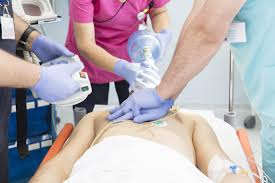“Heart attack” and “cardiac arrest” are often used interchangeably—but they are not the same thing. In fact, these two heart emergencies are very different in how they occur, what causes them, and how they should be treated.
Understanding the difference between a heart attack and cardiac arrest is more than just medical knowledge—it can help save a life, whether it’s your own or someone else’s.
Let’s break down the distinction clearly and simply.
What is a Heart Attack?
A heart attack (medically called myocardial infarction) happens when blood flow to part of the heart is blocked, usually by a clot in the coronary arteries. Without blood, that part of the heart begins to die due to lack of oxygen.
Causes:
- Coronary artery disease
- Plaque buildup (atherosclerosis)
- Blood clot formation
- Severe narrowing of arteries
Symptoms of a Heart Attack:
- Chest pain or pressure (often described as squeezing or fullness)
- Pain spreading to arm, jaw, back, or neck
- Shortness of breath
- Sweating
- Nausea or vomiting
- Light-headedness
- Fatigue, especially in women
Important Note: A person having a heart attack is usually awake and conscious and may experience symptoms for minutes to hours.
What is Cardiac Arrest?
A cardiac arrest is when the heart suddenly stops beating. This is an electrical problem in the heart that causes it to stop pumping blood to the brain and other organs.
Causes:
- Arrhythmia (especially ventricular fibrillation)
- Heart attack (can trigger cardiac arrest)
- Heart failure
- Drug overdose
- Trauma or severe blood loss
- Sudden electrolyte imbalances
Symptoms of Cardiac Arrest:
- Sudden collapse
- No pulse
- No breathing
- Loss of consciousness
- Possible gasping (agonal breathing) in early moments
Important Note: A person in cardiac arrest becomes unconscious within seconds and will die within minutes without emergency treatment.
Key Differences at a Glance
| Feature | Heart Attack | Cardiac Arrest |
|---|---|---|
| What Happens | Blocked blood flow to heart muscle | Heart stops beating suddenly |
| Cause | Blocked artery (circulatory problem) | Electrical malfunction of the heart |
| Consciousness | Usually conscious (initially) | Always unconscious immediately |
| Symptoms | Chest pain, breathlessness, sweating | Sudden collapse, no pulse or breathing |
| Treatment Needed | Emergency medical care, medication, surgery | CPR + defibrillation (AED) immediately |
| Is It Reversible? | Yes, if treated quickly | Yes, if CPR and defibrillation are given fast |
How Are They Connected?
A heart attack can lead to cardiac arrest, but not always. In fact:
- Most heart attacks do not cause cardiac arrest
- However, many cardiac arrests are caused by an underlying heart attack
That’s why recognizing the early signs of a heart attack and seeking treatment immediately is crucial—it can prevent sudden cardiac death.
What To Do in an Emergency
🚨 If Someone is Having a Heart Attack:
- Call emergency services immediately (e.g., 911)
- Keep the person calm and seated
- Loosen any tight clothing
- Give aspirin (if advised and not allergic)
- Monitor for signs of cardiac arrest
⚡ If Someone is in Cardiac Arrest:
- Call emergency services immediately
- Start CPR (chest compressions) immediately
- Use an AED (automated external defibrillator) if available
- Continue CPR until help arrives or the person revives
How to Prevent Both Conditions
- Control blood pressure and cholesterol
- Quit smoking
- Eat a heart-healthy diet
- Exercise regularly
- Manage stress
- Get regular heart checkups, especially if you have family history
Conclusion: Know the Difference, Save a Life
A heart attack is a circulation problem; cardiac arrest is an electrical failure of the heart. They may be connected, but they are not the same—and each requires a different emergency response.
Knowing the difference can make you better prepared to act quickly, which can mean the difference between life and death.

